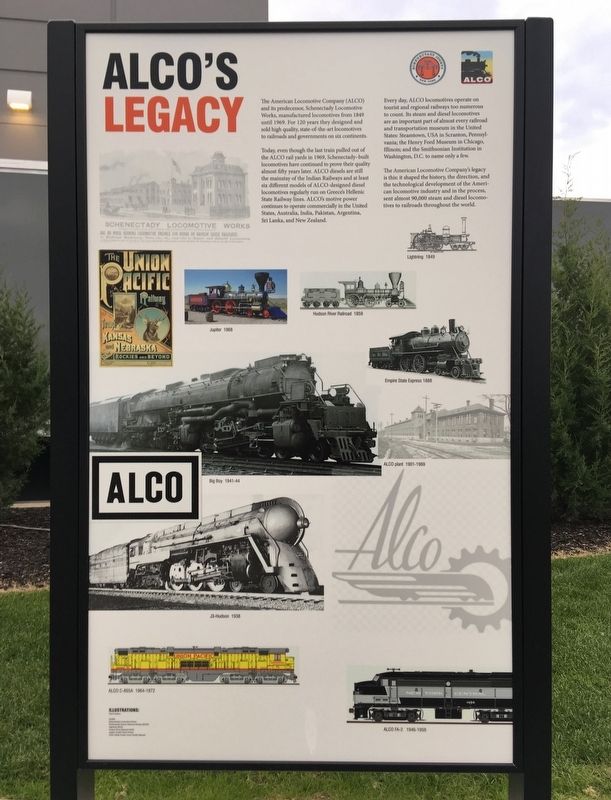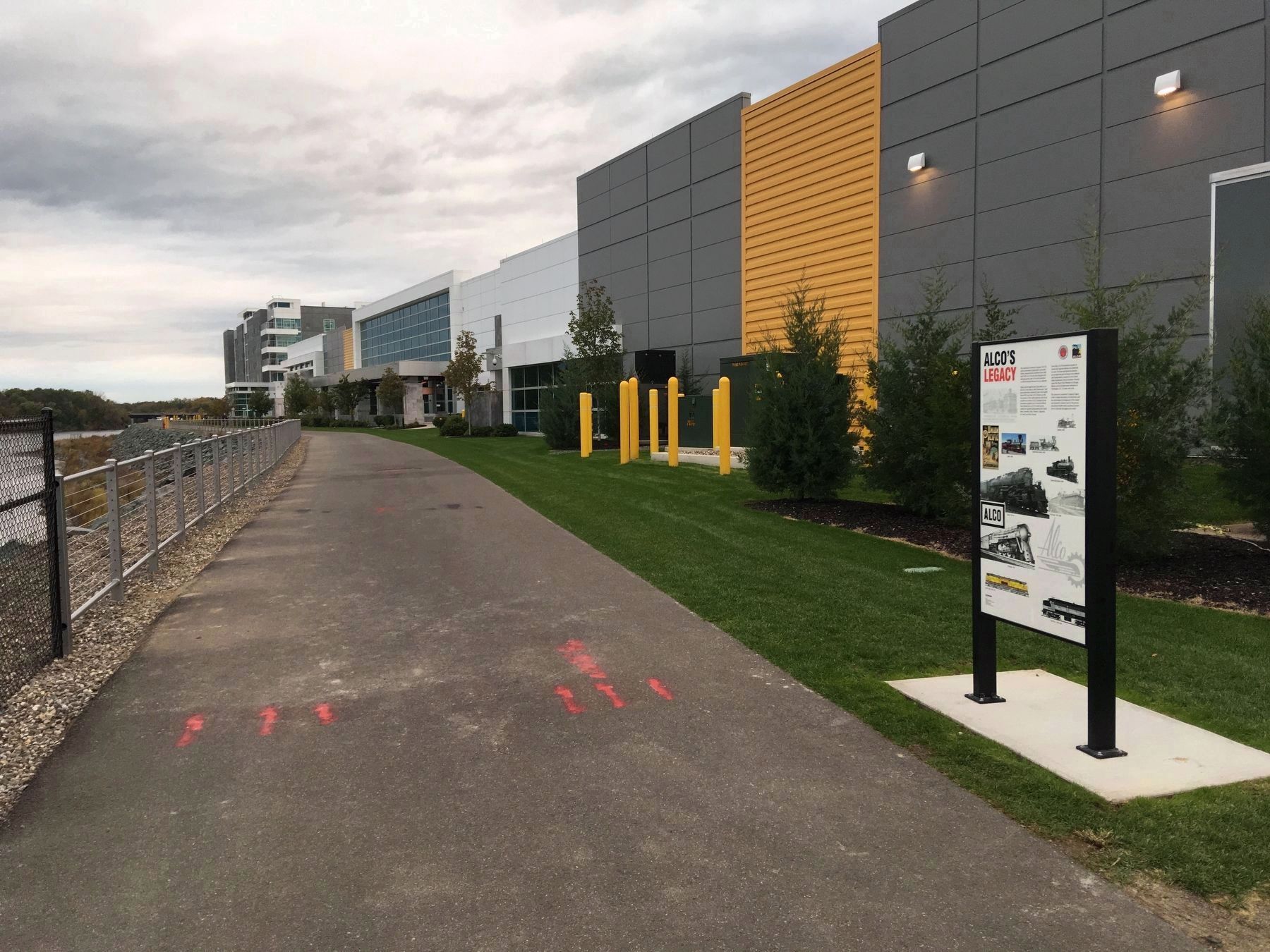Schenectady in Schenectady County, New York — The American Northeast (Mid-Atlantic)
ALCo's Legacy
Today, even though the last train pulled out of the ALCO rail yards in 1969, Schenectady-built locomotives have continued to prove their quality almost fifty years later. ALCO diesels are still the mainstay of the Indian Railways and at least six different models of ALCO-designed diesel locomotives regularly run on Greece's Hellenic State Railway lines. ALCO's motive power continues to operate commercially in the United States, Australia, India, Pakistan, Argentina, Sri Lanka, and New Zealand.
Every day, ALCO locomotives operate on tourist and regional railways too numerous to count. Its steam and diesel locomotives are an important part of almost every railroad and transportation museum in the United States: Steamtown, USA in Scranton, Pennsylvania; the Henry Ford Museum in Chicago, Illinois; and the Smithsonian Institution in Washington, D.C. to name only a few.
The American Locomotive Company's legacy is this: it shaped the history, the direction, and the technological development of the American locomotive industry and in the process, sent almost 90,000 steam and diesel locomotives to railroads throughout the world.
Erected 2018 by the Schenectady County Legislature.
Topics. This historical marker is listed in these topic lists: Industry & Commerce • Railroads & Streetcars. A significant historical year for this entry is 1849.
Location. 42° 49.38′ N, 73° 56.32′ W. Marker is in Schenectady, New York, in Schenectady County. This marker is located along the bike-hike trail behind the casino. Touch for map. Marker is in this post office area: Schenectady NY 12305, United States of America. Touch for directions.
Other nearby markers. At least 8 other markers are within walking distance of this marker. The “Works” (about 500 feet away, measured in a direct line); Dewitt Clinton (about 600 feet away); "Jupiter" (approx. ¼ mile away); Schenectady (approx. ¼ mile away); Casey Jones (approx. ¼ mile away); Streamliners (approx. 0.3 miles away); ALCo Site (approx. 0.3 miles away); "Big Boy" (approx. 0.4 miles away). Touch for a list and map of all markers in Schenectady.
More about this marker. “ALCo Heritage Trail”- Eleven new interpretive signs that celebrate the history of the American Locomotive Company (ALCo) are now in place along a two-mile bike-hike trail on Schenectady’s rejuvenated waterfront. This section of the bike-hike trail passes through the area that had been the site of the ALCo
factory, and which has since been redeveloped with the $500 million, includes Mohawk Harbor, the Rivers Casino & Resort, the Marriot hotel, and the Riverhouse Apartments. Mohawk Harbor is the largest waterfront development in Upstate New York. The ALCo Heritage Trail runs along the riverfront, from River Street, through Mohawk Harbor, and under Freeman’s Bridge where the trail runs up Maxon Road and connects with the NYS Canalway Trail.
Sponsored and funded by the Schenectady County Legislature, the new trail signs celebrate the history of ALCo and honors the thousands of Schenectadians who helped shape transportation and military history through their work at ALCo. From 1847 to 1969, the ALCo plant in Schenectady built some of the biggest and best locomotives the world has ever known. Tanks manufactured by ALCo played a major role in helping the United States win World War II.
“From Casey Jones to Big Boy, from the Golden Spike to the first passenger railroad in the country, ALCo played a major role in American History. The new ALCo Heritage Trail tells the story of how Schenectady became the city that lights and hauls the world,” said Gary Hughes, Majority Lead of the Schenectady County Legislature and Chairman of the Legislature’s Committee on Economic Development.
The Schenectady County Department of Economic Development and Planning built the trail signage using $30,000 provided by the County Legislature.
The Alco trail signs mark many milestones in the history of the company and Schenectady including:
• First passenger railroad in the United States from Albany to Schenectady.
• Establishment of the Schenectady Locomotive Works in 1847.
• The Golden Spike on the first transcontinental railroad in 1869 and the first locomotive to cross the tracks – the Jupiter built in Schenectady.
• Casey Jones, famed engineer, was driving an Alco locomotive in 1900 during his famous train ride later memorialized in song.
• Schenectady, City that Lights and Hauls the World.
• Alco Streamliners built in the 1920s.
• Big Boy, the biggest locomotive ever built anyplace in the world, built in Schenectady from 1941 to 1944.
• Alco’s role in World War II.
• Alco’s legacy.
The 'ALCo Legacy' marker here, and another duplicate marker with the same text, appear to be bookends for the series of markers along the ALCo Heritage Trail.
Credits. This page was last revised on November 1, 2018. It was originally submitted on October 27, 2018, by Howard C. Ohlhous of Duanesburg, New York. This page has been viewed 269 times since then and 32 times this year. Photos: 1, 2. submitted on October 27, 2018, by Howard C. Ohlhous of Duanesburg, New York. • Andrew Ruppenstein was the editor who published this page.

